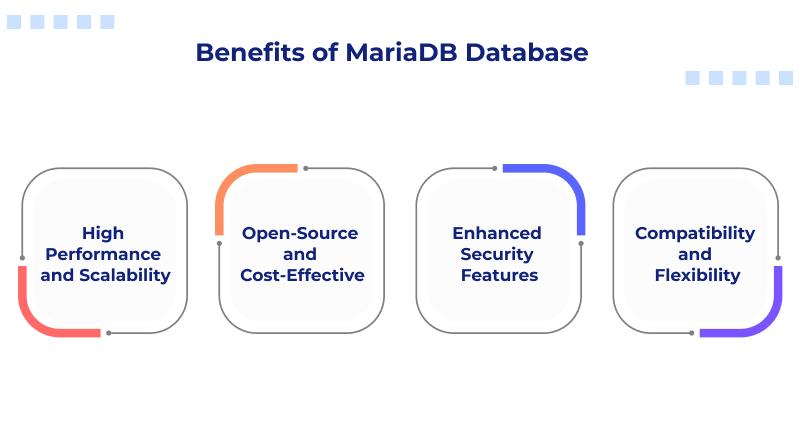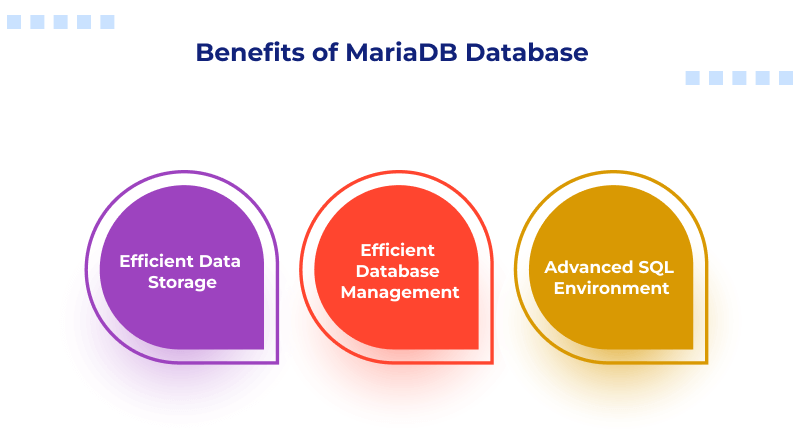MariaDB (Maria Data Base) is an open-source database that stores and organizes data like MySQL. Both are different database systems but have unique features. Thus, MariaDB is used for special purposes like data warehousing, eCommerce, enterprise-level features, and logging applications. All these web assets get an online presence through MariaDB hosting services. It effectively handles the workload. Also, it is functional in any cloud database and works at any scale.
This detailed article provides an introductory guide to MariaDB. We will discuss its main features, history and development, and security parameters. Read on!
Table Of Content
What is a Database?
Before we jump into the MariaDB overview, let beginners understand the database’s meaning first. In a Word document, users have to write every piece of information. It is challenging to retrieve any data from the Word file. MariaDB makes data retrieval simple, fast, and accurate.
A database comprises multiple tables known as relations. Each relation contains several cells in vertical and horizontal format, like an Excel sheet. Due to this, MariaDB is also known as a relational database. Database languages, such as SQL or Structured Query Language, are popular ways to communicate with databases.
History
Michael, a.k.a. Monty Widenius, forked MySQL in 2009 after the Oracle acquisition. As one of MySQL’s original developers, he named the new project MariaDB after his second daughter, Maria.
Monty avoided any acquisition of MariaDB, as happened with MySQL. Hence, he founded the database software in December 2012. The primary objective to initiate this database was to serve as a global point for open collaboration.
What Is MariaDB Database?
MariaDB is an open-source relational database management system (RDBMS) that is a drop-in replacement for MySQL. The original creators of MySQL developed it after concerns arose regarding Oracle Corporation’s acquisition of MySQL. Switching between MariaDB and MySQL is easier without making significant changes. Due to its speed, scalability, and reliability, it is widely used for web applications, enterprise solutions, and cloud services.
One of MariaDB’s major strengths is its advanced features and performance improvements over MySQL. It includes a variety of powerful storage engines, such as Aria, ColumnStore, and XtraDB, which enhance data handling capabilities. Additionally, MariaDB supports advanced clustering solutions, replication methods, and security enhancements, making it suitable for high-availability and mission-critical applications. Continuous updates from an active community of developers ensure that MariaDB remains secure, stable, and feature-rich.
Flexibility is the next factor, as it operates on multiple operating systems. Different OS like Linux, Windows, and macOS. It is integrated seamlessly with popular programming languages like Python, PHP, and Java. It makes the preferred choice for developers. Industry giants like Wikipedia and Google trust MariaDB for their powerful database needs. MariaDB, being open-source with solid performance and sounding community support, has been an evergreen choice in modern database management.
Benefits of MariaDB Database
MariaDB database is an open-source software that allows users to store and manage data. CMS (Content Management Systems) is the best application of MariaDB. MariaDB is a relational database management system that runs on your WordPress hosting server and handles multiple users and databases. Do you want to know more benefits? Here we go!

1. High Performance and Scalability
MariaDB is an optimized database for speed that efficiently handles high concurrent connection numbers. It incorporates several advanced storage engines, like Aria and XtraDB, which enhance performance and transaction processing. Additionally, MariaDB supports parallel query execution and advanced indexing techniques, making it an excellent choice for large-scale applications.
Scalability is yet another great advantage of MariaDB. It supports master-slave and multi-source replication architectures that facilitate the distribution of databases over multiple servers. This will ensure that businesses can distribute their workload well, which will, in turn, allow them to scale welding businesses efficiently without performance degradation.
2. Open-Source and Cost-Effective
We mentioned this point in our introduction. MariaDB is an open-source database for businesses of all sizes. Organizations do not have to invest huge capital in its security updates because MariaDB is community-driven.
MariaDB is compatible with MySQL and allows easy migration from MySQL without making significant changes to applications. This reduces operational expenses, and disrupts business operations while offering a cost-effective yet powerful alternative to other proprietary database solutions.
3. Enhanced Security Features
MariaDB comes with robust security mechanisms to protect sensitive data. It supports advanced tables, logs, and communications encryption, ensuring data integrity and confidentiality. Additionally, it offers fine-grained access controls, allowing administrators to set specific user privileges and roles for better security management.
MariaDB frequently releases security patches and updates to protect the system against vulnerabilities. Features like password validation plugins and user account locking further strengthen security, making MariaDB a reliable choice for handling critical business data.
4. Compatibility and Flexibility
MariaDB is highly compatible with MySQL, allowing users to leverage existing tools, applications, and configurations without significant modifications. It ensures an easy transition for organizations looking to switch database management systems without any significant downtime.
Furthermore, MariaDB supports multiple storage engines and database types, making it highly flexible for several use cases. It integrates seamlessly with cloud platforms, web applications, and enterprise software, making it a versatile database choice across industries.
Popular MariaDB Databases Commands
Here are the popular MariaDB database commands to execute.
– Connecting to MariaDB
This logs in as the root user and prompts for a password.
MySQL -u root –p– Show Databases
Shows all available databases.
SHOW DATABASES;– Create a Database
Creates a new database named mydatabase.
CREATE DATABASE mydatabase;– Create a Table
This command is used to create a table in MariaDB. You can use fields like id, name, email, and created_at,
CREATE TABLE users (
id INT AUTO_INCREMENT PRIMARY KEY,
name VARCHAR(100),
email VARCHAR(100) UNIQUE,
created_at TIMESTAMP DEFAULT CURRENT_TIMESTAMP
);– Exit MariaDB
You can exit the MariaDB database by executing the following command.
EXIT;MariaDB vs MySQL: Which is Better?
Throughout the content, we have discussed several insights on the MySQL and MariaDB. The tabular comparison between MaraDB vs MySQL is her given below.
| Feature | MariaDB | MySQL |
| Initial Release | 2009 | 1995 |
| Current Version | 11.1 | 8 |
| Primary Developer | MariaDB Foundation | Oracle Corporation |
| Licensing | GNU General Public License version 2 | GNU General Public License version 2 with commercial options |
| Default Storage Engine | InnoDB | InnoDB |
| Thread Pooling | Available in the community edition | Available only in the enterprise edition |
| Additional Storage Engines | Aria, TokuDB, MyRocks, and more | Limited compared to MariaDB |
| JSON Support | Stores JSON as strings, more JSON functions | Stores JSON as binary objects |
| Oracle Compatibility | High, with support for PL/SQL | Some compatibility, limited PL/SQL support |
| Security Features | More options for encryption, enhanced password security | Robust security features |
| Performance | Often faster in benchmarks, especially with large datasets | Reliable performance |
| Community | Strong and active community | Larger user base and ecosystem |
What is MariaDB Used For?

1. Efficient Data Storage
The relational database management system (RDBMS) used for efficient data storage and retrieval is MariaDB which is a popular open source relational database management system. It is used commonly on different applications like Web development, Enterprise solutions and Cloud services. Structured data management with SQL is guaranteed by MariaDB while still keeping query processing speed fast. Reliability and scalability make it the preferred decision for its large amounts of data handling.
2. Efficient Database Management
With such great potential of database management, MariaDB is very common in different web applications and cloud platforms. This allows the developer to store, manage, and also manipulate the data easily. MariaDB supports SQL (which allows developers to integrate it with many programming languages and frameworks) and the language it has just been saving you from. It is used by MariaDB businesses and developers to create high performance applications which have a strong data handling capacity.
3. Advanced SQL Environment
As an advanced SQL environment, MariaDB with its replication and clustering support as well as its being highly available, powers many websites. Replication is for synchronizing the data among many servers, which is the meaning of redundancy or fault tolerance. It allows large scale applications not to be stopped. MariaDB is a trusted solution for important applications with uptime demands regardless of continuous uptime demands.
MariaDB has been positioned as a worthy replacement to MySQL, with better performance, improved security and better scalability. Being a beginner learning about databases or an enterprise in search of a popular database solution, MariaDB offers the flexibility and efficiency you need for all your needs.
The best MariaDB hosting experience will be given to you by a reliable hosting provider with good performance and security. That’s where MilesWeb comes in! MilesWeb offers its databases hassle free with high speed servers, 24×7 expert support and MariaDB hosting with full management.
Now is the time to begin your journey with MariaDB with MilesWeb top class hosting and enjoyapseudonymeshorten bufferFlush() performance!
FAQs
How does MariaDB compare to other popular databases like MySQL and PostgreSQL?
MariaDB is a fork of MySQL based on a Google Chrome like project model for better performance, security, and scalability while keeping compatibility. MariaDB is considerably easier to use than PostgreSQL and is basically integrated with MySQL applications, whereas PostgreSQL provides advanced features for complex queries and high concurrency. Both databases are strong but MariaDB is the chosen one due to speed, simplicity, and open-source, community driven development.
What are some everyday use cases for MariaDB?
MariaDB is very popular because of its scalability, availability and it’s widely used for web applications, enterprise solutions and cloud based services. It is also a great option for e-commerce platform, content management systems (CMS) and data analytics. If you are meant to handle structured data efficiently, for example, many businesses going with the MariaDB is because it is so flexible, so secure and so cost efficient.
Is MariaDB suitable for large-scale applications?
MariaDB is quite suited for large scale applications as it supports replication and clustering and Galera Cluster is a highly available feature. With its optimization tools, cloud compatibility, ability to handle millions of queries per second, it is the best solution for an enterprise application, a financial system and for a high traffic website.
How is MariaDB maintained and developed?
MariaDB Foundation is developing and maintaining MariaDB together with passionate community. It is at the very latest with every database technology update, security patch and performance enhancing. MariaDB continues to be a reliable, secure, and future ready database solution for modern applications from around the world with the help of developers.















